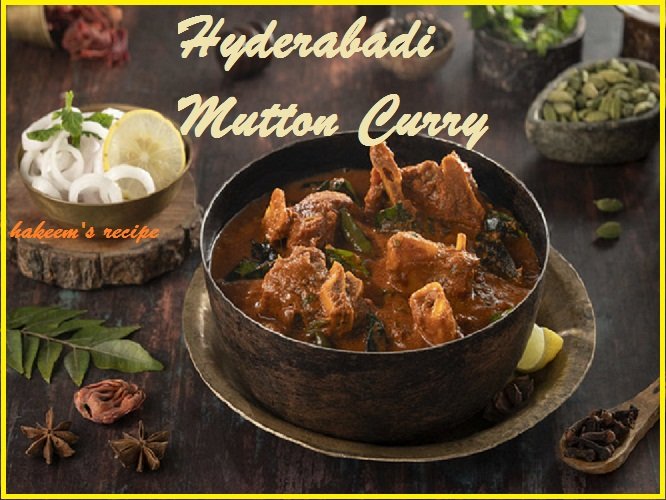
Hyderabadi Mutton Curry: Ultimate Guide
Hyderabadi Mutton Curry is a delectable and aromatic dish, cherished for its rich flavors and tender meat. In this guide, we’ll walk you through the steps to create this authentic Hyderabadi delicacy, ensuring your dish turns out perfect every time.
Chapter 1: Introduction to Hyderabadi Mutton Curry
Hyderabadi cuisine is renowned for its rich flavors and use of aromatic spices. Mutton curry, a staple in Hyderabadi households, is a hearty dish that combines tender mutton with a blend of spices, tomatoes, and onions. This chapter provides an overview of the dish, its history, and its significance in Hyderabadi culture.
Chapter 2: Ingredients Required
Before starting to cook, make sure you have all the required ingredients on hand. Here’s what you’ll need:
1 kg mutton, cut into pieces
2 large onions, finely sliced
2 tomatoes, chopped
1 cup yogurt
2 tablespoons ginger-garlic paste
4 green chilies slit
1 cup fresh coriander leaves, chopped
1 cup fresh mint leaves, chopped
1 teaspoon turmeric powder
2 teaspoons red chili powder
2 teaspoons coriander powder
2 teaspoons garam masala
4 tablespoons oil
Salt to taste
Chapter 3: Preparing the Marinade
Marinating the mutton is crucial for infusing it with flavor and ensuring it remains tender. Follow these steps:
Mix yogurt with ginger-garlic paste, turmeric powder, red chili powder, and salt in a large bowl.
Add the mutton pieces to the marinade, ensuring they are well-coated.
Cover the bowl and refrigerate for a minimum of 2 hours, ideally overnight for optimal flavor.
Chapter 4: Preparing the Spice Mix
A unique blend of spices sets Hyderabadi Mutton Curry apart. Prepare the spice mix as follows:
In a dry skillet, roast the following spices until fragrant: 2 teaspoons cumin seeds, 2 teaspoons coriander seeds, 4 cloves, 2-inch cinnamon stick, 4 green cardamom pods.
Grind the roasted spices into a fine powder using a spice grinder or mortar and pestle.
Chapter 5: Cooking the Mutton
Now, it’s time to cook the marinated mutton. Follow these steps:
In a large, heavy-bottomed pot, heat oil over medium heat. Add sliced onions and cook until they turn golden brown.
Stir in the tomatoes and cook until they become soft and mushy.
Add the marinated mutton to the pot and cook on high heat for 5-7 minutes, stirring continuously.
Reduce the heat to medium and add the roasted spice mix, coriander powder, and garam masala.
Cook for another 10 minutes, allowing the spices to blend with the mutton.
Chapter 6: Slow Cooking for Tenderness
Slow cooking is key to achieving tender mutton that melts in your mouth. Here’s how:
Pour 2 cups of water into the pot and bring it to a boil.
Reduce the heat to low, cover the pot, and let it simmer for 45 minutes to 1 hour, or until the mutton is tender.
Occasionally stir and add additional water as necessary to achieve the desired consistency.

Chapter 7: Final Touches
To enhance the flavor and aroma of the curry, follow these final steps:
Add the slit green chilies, chopped coriander, and mint leaves to the pot.
Stir well and let the curry simmer for an additional 10 minutes.
Taste and adjust the seasoning if necessary.
Chapter 8: Serving Suggestions
Hyderabadi Mutton Curry is best enjoyed with steamed rice or Indian bread like naan or roti. For a complete meal, serve it alongside raita (yogurt sauce) and a fresh salad.
Chapter 9: Tips for the Perfect Mutton Curry
Here are some tips to ensure your mutton curry turns out perfect:
Use fresh, good-quality mutton for the best flavor and texture.
Marinate the mutton for an adequate amount of time to enhance its taste.
Slow cooking is essential for tender meat; avoid rushing the process.
Adjust the amount of spices to suit your taste.
Chapter 10: Variations of Hyderabadi Mutton Curry
While the traditional recipe is unbeatable, you can experiment with variations to suit your taste:
Spicier Version: Increase the quantity of green chilies and red chili powder.
Creamy Version: Add a splash of cream or coconut milk towards the end of cooking.
Healthier Version: Use less oil and incorporate more vegetables like potatoes or peas.
Chapter 11: Storing and Reheating Hyderabadi Mutton Curry
Hyderabadi Mutton Curry often tastes even better the next day as the flavors continue to develop. Here’s how to store and reheat it:
Storing
Cool Down: Allow the curry to cool down to room temperature before storing.
For refrigeration, transfer the curry to an airtight container. It can be stored and kept fresh for up to 3 days.
Top of Form
Bottom of Form
Freezing: For longer storage, freeze the curry in portions. It can be stored in the freezer for up to 2 months.
Reheating
Stovetop: Place the curry in a pot and heat over medium-low heat, stirring occasionally until it’s heated through.
Microwave: Transfer a portion to a microwave-safe bowl, cover it, and heat on medium power, stirring every 1-2 minutes until it’s hot.
Chapter 12: Nutritional Information
Understanding the nutritional content of Hyderabadi Mutton Curry can help you enjoy it as part of a balanced diet. Here’s a rough breakdown:
Calories: Approximately 350-400 calories per serving
Protein: 20-25 grams
Fat: 25-30 grams
Carbohydrates: 10-15 grams

Nutritional Benefits
High in Protein: Mutton is an excellent source of high-quality protein, essential for muscle repair and growth.
Rich in Vitamins and Minerals: It provides essential nutrients like iron, zinc, and B vitamins.
Healthy Fats: The use of yogurt and minimal oil ensures a good balance of healthy fats.
Chapter 13: Pairing Beverages with Hyderabadi Mutton Curry
Choosing the right beverage can enhance your dining experience. Here are some suggestions:
Yogurt-Based Drinks: Lassi or buttermilk helps balance the spiciness of the curry.
Traditional Indian Drinks: Masala chai or spiced tea pairs well with the rich flavors.
Wine: A light, fruity red wine like Pinot Noir or a crisp white wine like Sauvignon Blanc can complement the dish.
Chapter 14: Common Mistakes to Avoid
Avoid these pitfalls to ensure your Hyderabadi Mutton Curry turns out perfectly:
Overcooking the Mutton: This can make the meat tough. Cook on low heat to keep it tender.
Not Marinating Long Enough: Skipping or shortening the marination time can result in less flavorful meat.
Using Too Much Water: Adding too much water can dilute the flavors. Gradually add water and adjust as necessary.
Skipping Fresh Herbs: Fresh coriander and mint are crucial for authentic flavor; don’t omit them.
Chapter 15: Frequently Asked Questions
Can I use lamb instead of mutton?
Certainly, lamb can be used as an alternative to mutton in this recipe.Just adjust the cooking time as lamb tends to cook faster than mutton.
How can I make the curry less spicy?
To reduce spiciness, use fewer green chilies and red chili powder. You can also add a bit of cream or yogurt at the end to mellow the heat.
Is it necessary to use whole spices?
Whole spices provide a more complex flavor, but if you don’t have them, you can use pre-ground spices. Adjust the quantities to taste.
Chapter 16: Enhancing the Presentation
A beautifully presented dish can enhance your dining experience. Here’s how to present your Hyderabadi Mutton Curry:
Garnish: Sprinkle fresh coriander and mint leaves on top.
Serve Hot: Ensure the curry is served hot to enjoy its full flavor.
Side Dishes: Present with a side of steamed rice, naan, or roti, along with a fresh salad and raita.
Chapter 17: The Cultural Significance of Hyderabadi Mutton Curry
Hyderabadi Mutton Curry is more than just a dish; it’s a part of the rich cultural heritage of Hyderabad. It’s often prepared during special occasions and festivals, symbolizing hospitality and celebration. Understanding its cultural significance can deepen your appreciation for this dish.
Chapter 18: Exploring Other Hyderabadi Delicacies
If you enjoyed making Hyderabadi Mutton Curry, try your hand at other Hyderabadi dishes:
Hyderabadi Biryani: A fragrant rice dish with layers of spiced meat.
Hyderabadi Haleem: A slow-cooked stew made with meat, lentils, and wheat.
Bagara Baingan: Eggplants cooked in rich, spicy gravy.
Chapter 19: Sharing Your Culinary Creation
Share your Hyderabadi Mutton Curry with friends and family. You can also share your cooking journey on social media platforms with photos and videos, using hash tags like Hyderabadi Mutton Curry or Home Cooking. Engaging with online cooking communities can provide inspiration and feedback.
Chapter 20: Conclusion
Making Hyderabadi Mutton Curry is a rewarding culinary experience that brings the rich flavors of Hyderabad to your kitchen. By following this comprehensive guide, you’ll be able to create a delicious, authentic dish that will impress anyone who tastes it. Enjoy the process, experiment with flavors, and savor every bite of your homemade Hyderabadi Mutton Curry.






